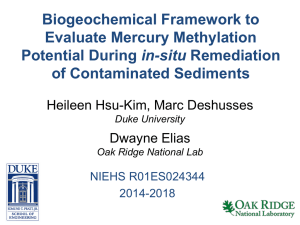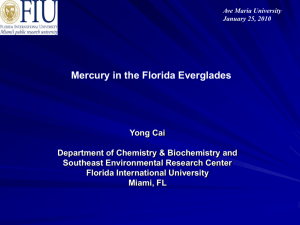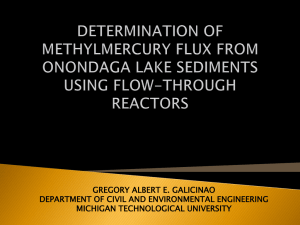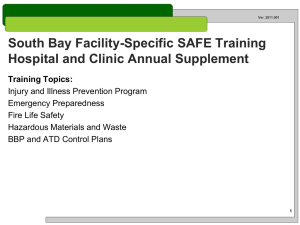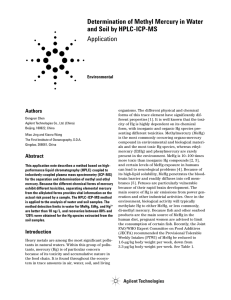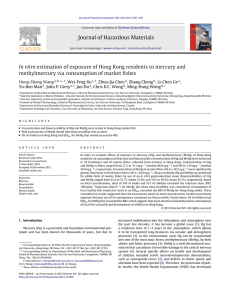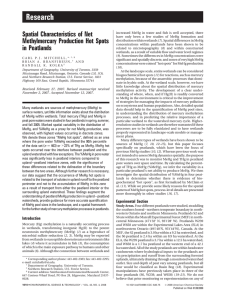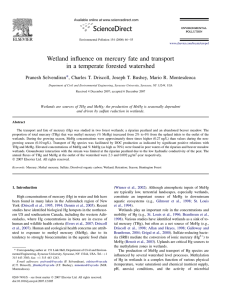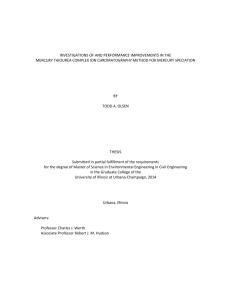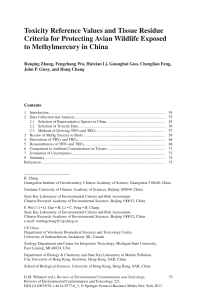Source Identification of Florida Bay`s Methylmercury Problem
advertisement
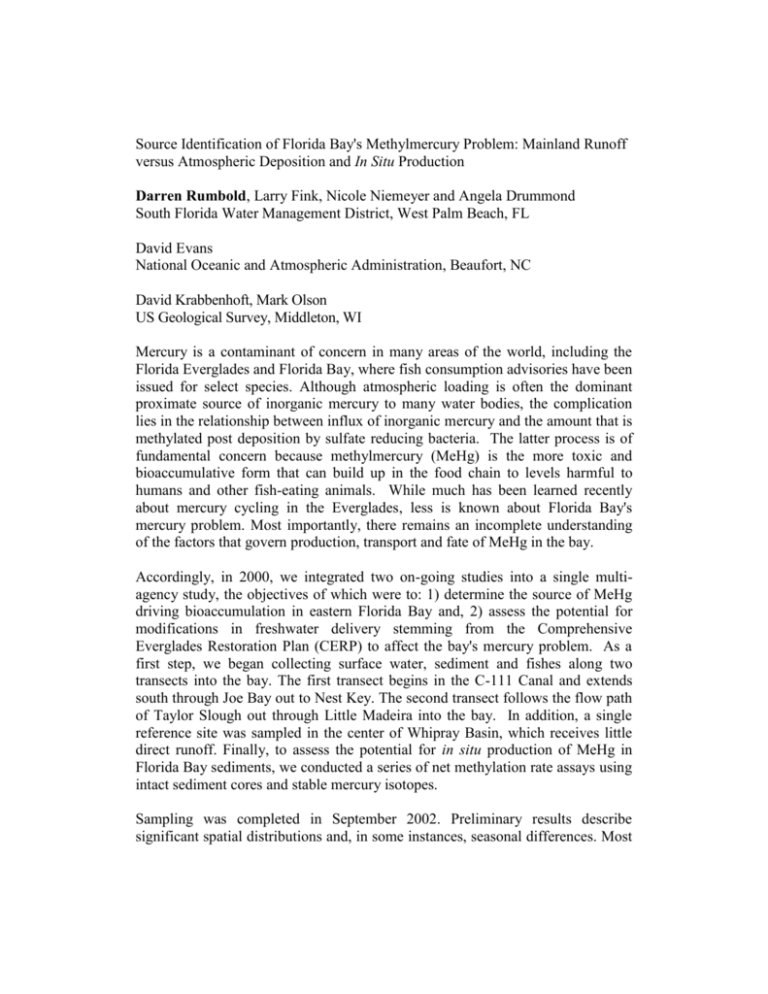
Source Identification of Florida Bay's Methylmercury Problem: Mainland Runoff versus Atmospheric Deposition and In Situ Production Darren Rumbold, Larry Fink, Nicole Niemeyer and Angela Drummond South Florida Water Management District, West Palm Beach, FL David Evans National Oceanic and Atmospheric Administration, Beaufort, NC David Krabbenhoft, Mark Olson US Geological Survey, Middleton, WI Mercury is a contaminant of concern in many areas of the world, including the Florida Everglades and Florida Bay, where fish consumption advisories have been issued for select species. Although atmospheric loading is often the dominant proximate source of inorganic mercury to many water bodies, the complication lies in the relationship between influx of inorganic mercury and the amount that is methylated post deposition by sulfate reducing bacteria. The latter process is of fundamental concern because methylmercury (MeHg) is the more toxic and bioaccumulative form that can build up in the food chain to levels harmful to humans and other fish-eating animals. While much has been learned recently about mercury cycling in the Everglades, less is known about Florida Bay's mercury problem. Most importantly, there remains an incomplete understanding of the factors that govern production, transport and fate of MeHg in the bay. Accordingly, in 2000, we integrated two on-going studies into a single multiagency study, the objectives of which were to: 1) determine the source of MeHg driving bioaccumulation in eastern Florida Bay and, 2) assess the potential for modifications in freshwater delivery stemming from the Comprehensive Everglades Restoration Plan (CERP) to affect the bay's mercury problem. As a first step, we began collecting surface water, sediment and fishes along two transects into the bay. The first transect begins in the C-111 Canal and extends south through Joe Bay out to Nest Key. The second transect follows the flow path of Taylor Slough out through Little Madeira into the bay. In addition, a single reference site was sampled in the center of Whipray Basin, which receives little direct runoff. Finally, to assess the potential for in situ production of MeHg in Florida Bay sediments, we conducted a series of net methylation rate assays using intact sediment cores and stable mercury isotopes. Sampling was completed in September 2002. Preliminary results describe significant spatial distributions and, in some instances, seasonal differences. Most importantly, levels of mercury in certain gamefish exceeded 0.5 mg/kg and sometimes exceeded 1.5 mg/kg (for further details on mercury in bay fishes, see Evans et al. this program). Concentrations of THg in unfiltered surface water collected quarterly along the transects ranged from 0.38 ng/l to 5.98 ng/l (median was 1.55 ng THg/l; n = 115); whereas MeHg concentrations ranged from <0.02 ng/l to 1.79 ng/l (median was 0.08 ng MeHg/l; n = 115). Both THg and MeHg concentration increased substantially in the mangrove transition zone following late summer rains, with concentration maxima occurring in Taylor River (Fig. 1). THg (ng/L) 7.0 M FW Marsh 6.5 A Argyle Henry pond 6.0 T Taylor River mouth A 5.5 L Little Madiera A T B Outer Bay 5.0 T R Whipray Basin ref. site 4.5 T T A A 4.0 R 3.5 A A 3.0 A T L 2.5 M B M L T M L A L 2.0 B R B L B A B B R 1.5 T T R T R LM B T R L R L R R B 1.0 B B R L A L M 0.5 0.0 2/00 6/00 10/00 2/01 6/01 10/01 2/02 6/02 10/02 1.8 A C1 C2 M J W T S N C111 at S178 C111 at S18C FW Marsh Joe Bay NE creek Joe Bay west Trout Creek Stump Pass Nest Key J W T J J T C1 C2 N S T S M N C1 C2 J T C1 J T S S N C1 C2 N C2 C1 T W J C2 N S T J S C2 M M W C1 C2 J T N S C1 N W T J M S C1 S J N T C1 M W C2 N N S C2 C2 C1 2/00 6/00 10/00 2/01 6/01 10/01 2/02 6/02 10/02 T 1.2 A A 0.6 T R A T B L R M L B 0.0 2/00 6/00 10/00 1000 A T A 0.3 Monthly mean flows (CFS) T 0.9 A A T R L B L A T R L B M R B M T R B L L A B T T B R L R 2/01 6/01 10/01 2/02 6/02 10/02 J J W C1 M J W M S J J N T M C2 C1 S T JM C2 J T C2 J C2 S J C1 T N T S N C2 T N S W W S T C2 W T N C1 S C2 N C2 N S C2 N C1 C1 N T S C1 C1 2/00 6/00 10/00 2/01 6/01 10/01 2/02 6/02 10/02 J B M R RM L B L C1 NM T S C1 C2 Taylor River flows Trout Creek flows 800 600 400 200 0 2/00 6/00 10/00 2/01 6/01 10/01 2/02 6/02 10/02 16 14 12 10 8 6 4 2 0 Monthly rainfall totals (in) MeHg (ng/L) 1.5 2/00 6/00 10/00 2/01 6/01 10/01 2/02 6/02 10/02 Date Fig. 1. Time series of total mercury (THg), methylmercury (MeHg), flows and rainfall (bars) measured along two transects into northeastern Florida Bay. Note, rainfall was recorded in Joe Bay and flows after 6/2002 not yet available. On average, non-filterable or dissolved forms (<0.45 µm) accounted for 80% and 73% of the total THg and MeHg, respectively. MeHg constituted 8% of the nonfilterable THg, but ranged up to 36% in the transition zone of Taylor River. Interestingly, concentrations of THg and MeHg in the surface water collected from the reference site in Whipray Basin (medians of 1.29 ng/L and 0.15 ng/L, respectively; n = 10) were not significantly different than concentrations observed along the two flowpaths. THg and MeHg in sediments collected semi-annually from the bay and upstream canals ranged from 5.8 to 145.6 ng/g dry weight (median was 19.9 ng THg/g) and from 0.05 to 5.4 ng/g dry weight (median was 0.26 ng MeHg/g), respectively. Although the highest median THg concentration occurred in sediment from the C111 Canal (115 ng/g), sediments from the mangrove transition zone along both flowpaths also contained relatively high levels of THg. The highest median sediment-MeHg (1.76 ng/g) occurred at the mouth of Taylor River. While these data must be normalized based on total organic carbon (measured in later cores) before any definitive conclusions can be reached, it was clear that sediments both from upstream marshes and from the bay often contained elevated concentrations of MeHg. Sediments collected from near Nest Key, for example, contained up to 1.8 ng MeHg/g, which constituted almost 8% of the THg present. These results came as a surprise because except for one or two recent studies, inhibition of mercury methylation had been reported for marine environments due to sulfidic porewaters and salinities. For these reasons, net methylation rates were measured in intact cores using stable isotope tracers of 202Hg (and more recently, to measure demethylation, CH3199Hg). Results from the first set of cores showed methylation rates in the 0-4 cm horizon to range from <1% to 11.2% conversion during the 24-h incubation period, with sediments from several sites in the bay having higher methylation rates than sediments from the mangrove transition zone. Although these data must be viewed in the context of a completed loading assessment, they indicate that mercury bioaccumulation in the bay is, at least in part, driven by in situ production. These data also indicate that to understand the bay's MeHg problem will require a more complete understanding of the fluxes and bioavailability of inorganic mercury for methylation. When completed, results of this study should improve our understanding of mercury cycling in Florida Bay, and our ability to make informed decisions about the management of Everglades's inflows for the restoration of the sport fishery and the protection of fish-eating wildlife in Florida Bay. Rumbold, Darren, SFWMD, Mail code 4720, 2301 McGregor Blvd, Ft. Myers, FL 33901, 941-338-2929, Fax 941-338-2936, drumbol@sfwmd.gov, Question 5




![[Company Name] Certificate of Completion](http://s2.studylib.net/store/data/005402466_1-8a11f4ced01fd5876feee99f8d8e6494-300x300.png)
